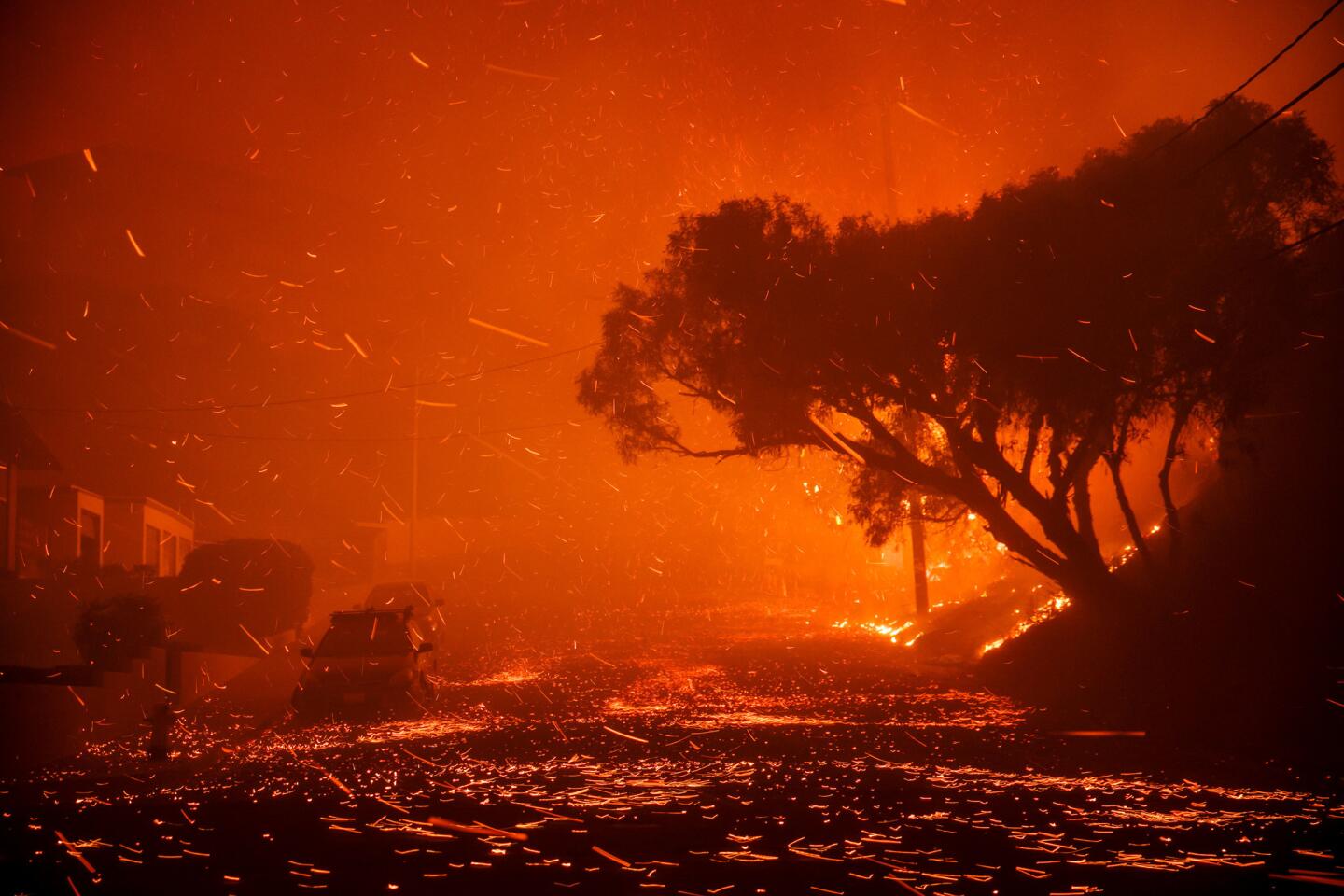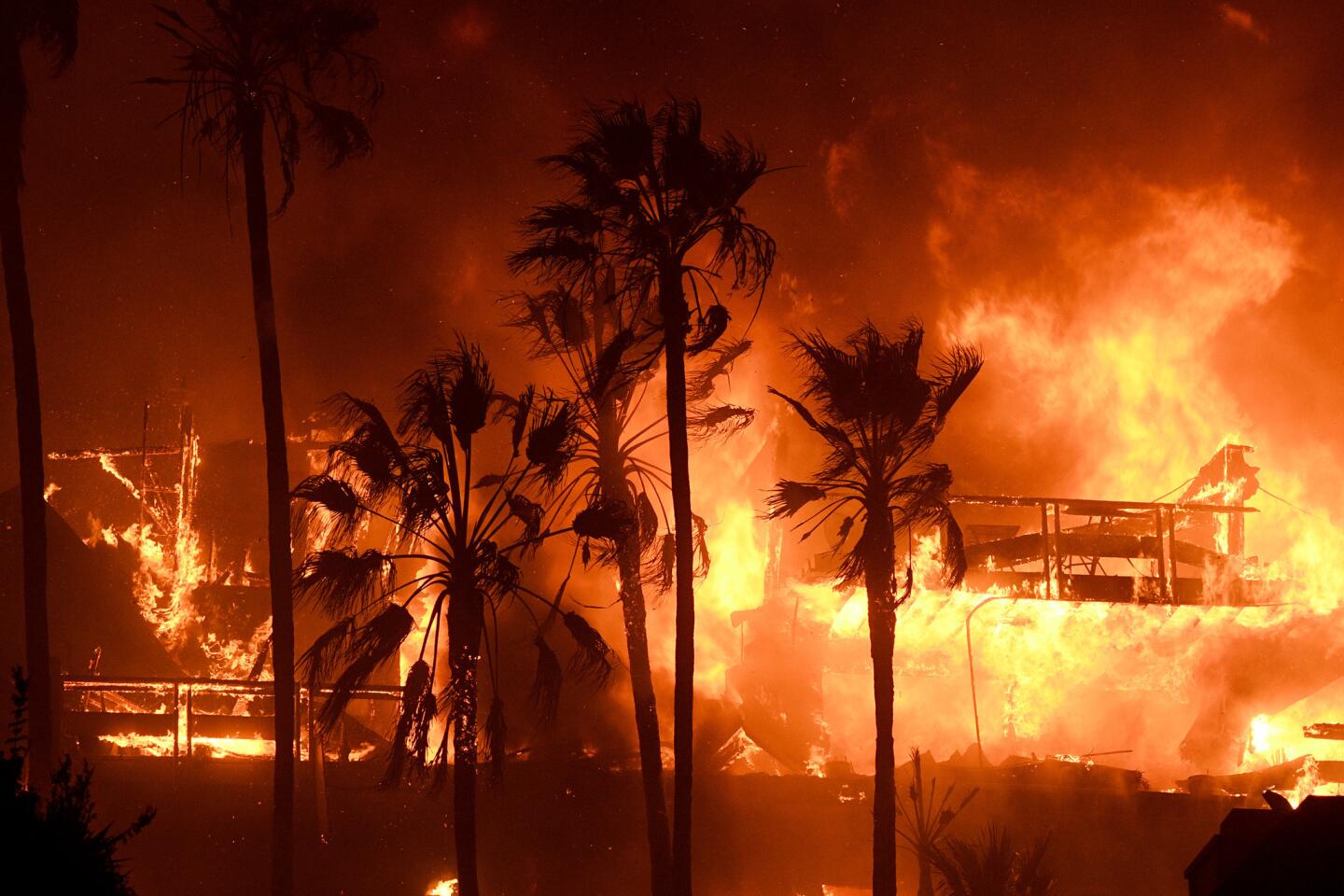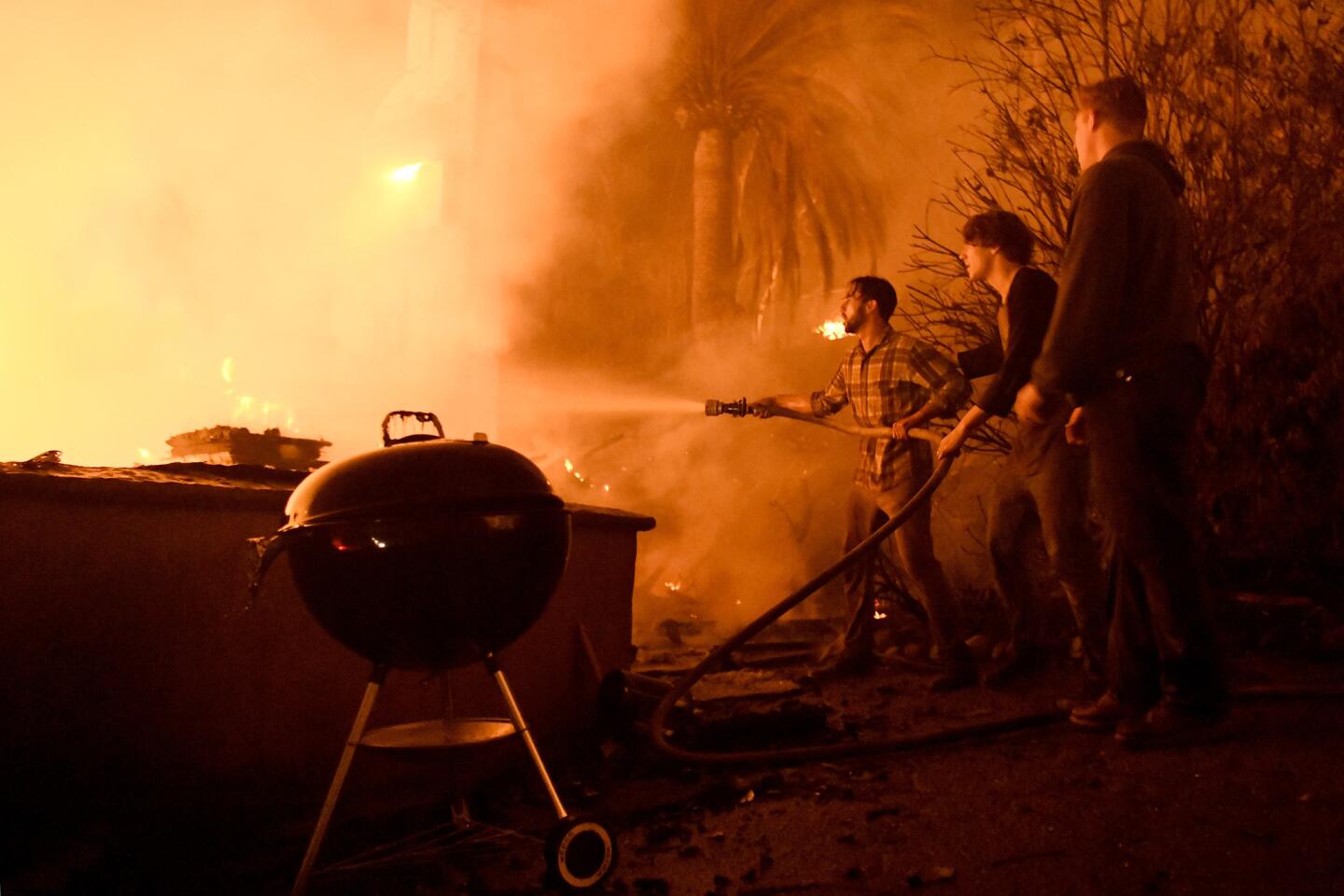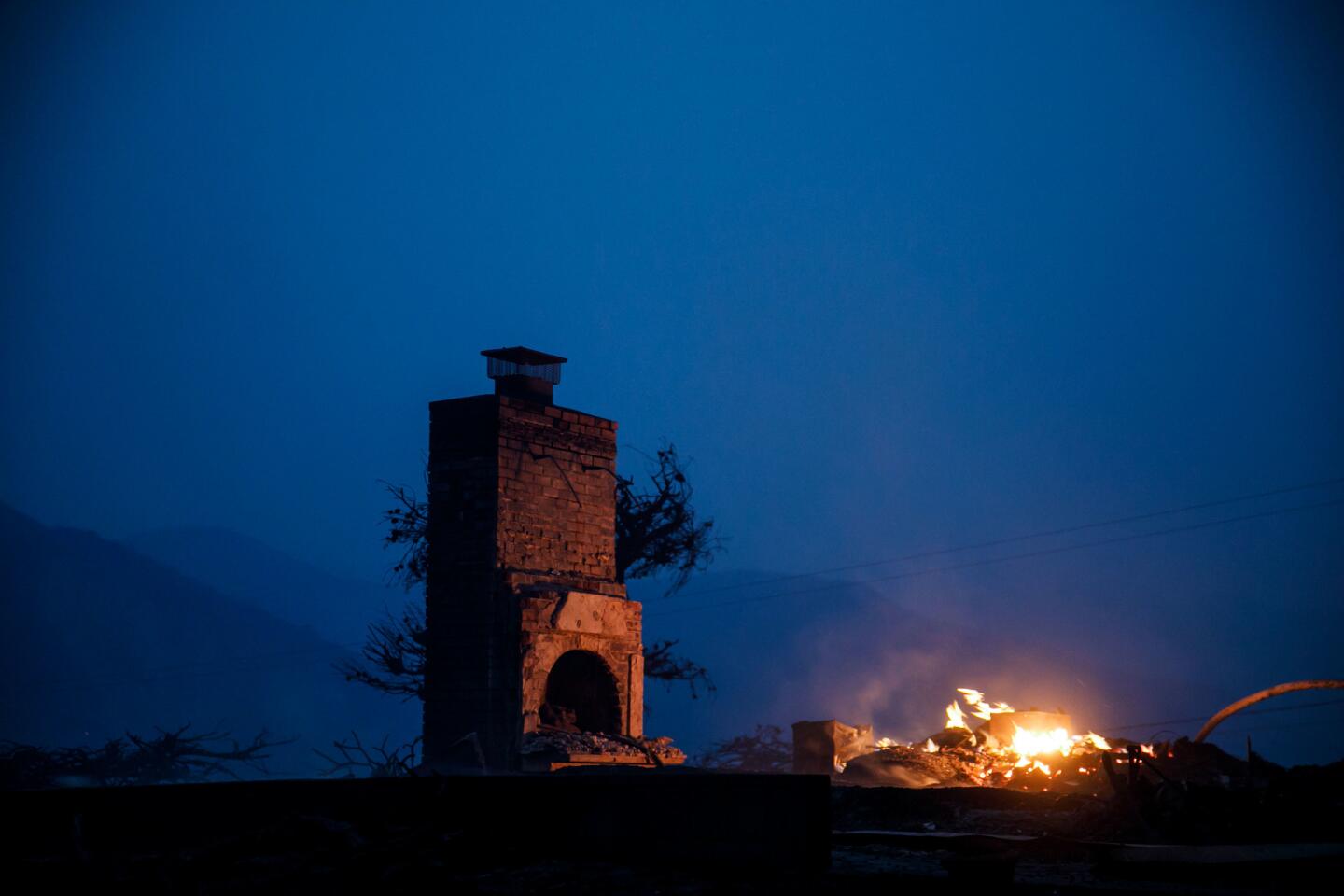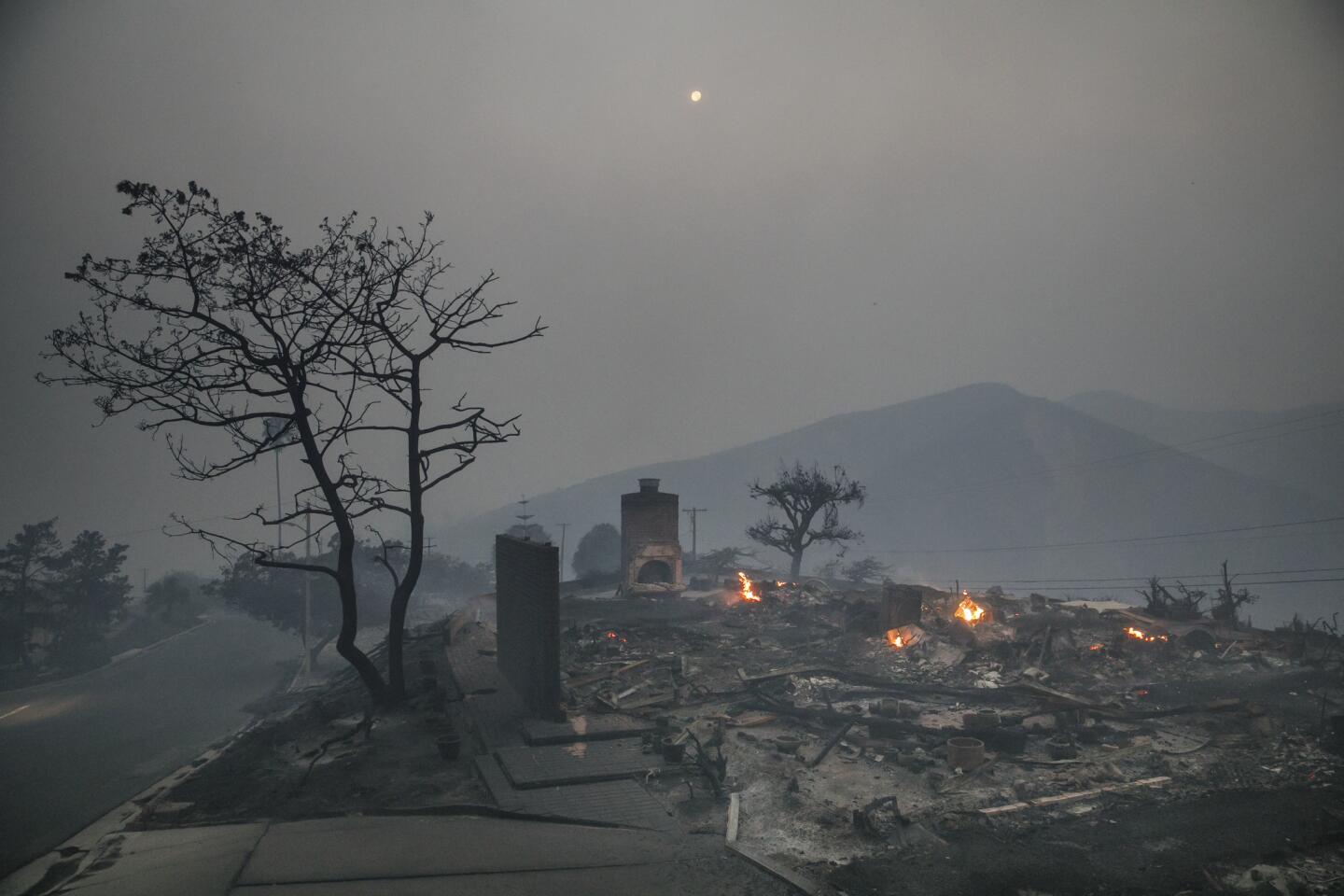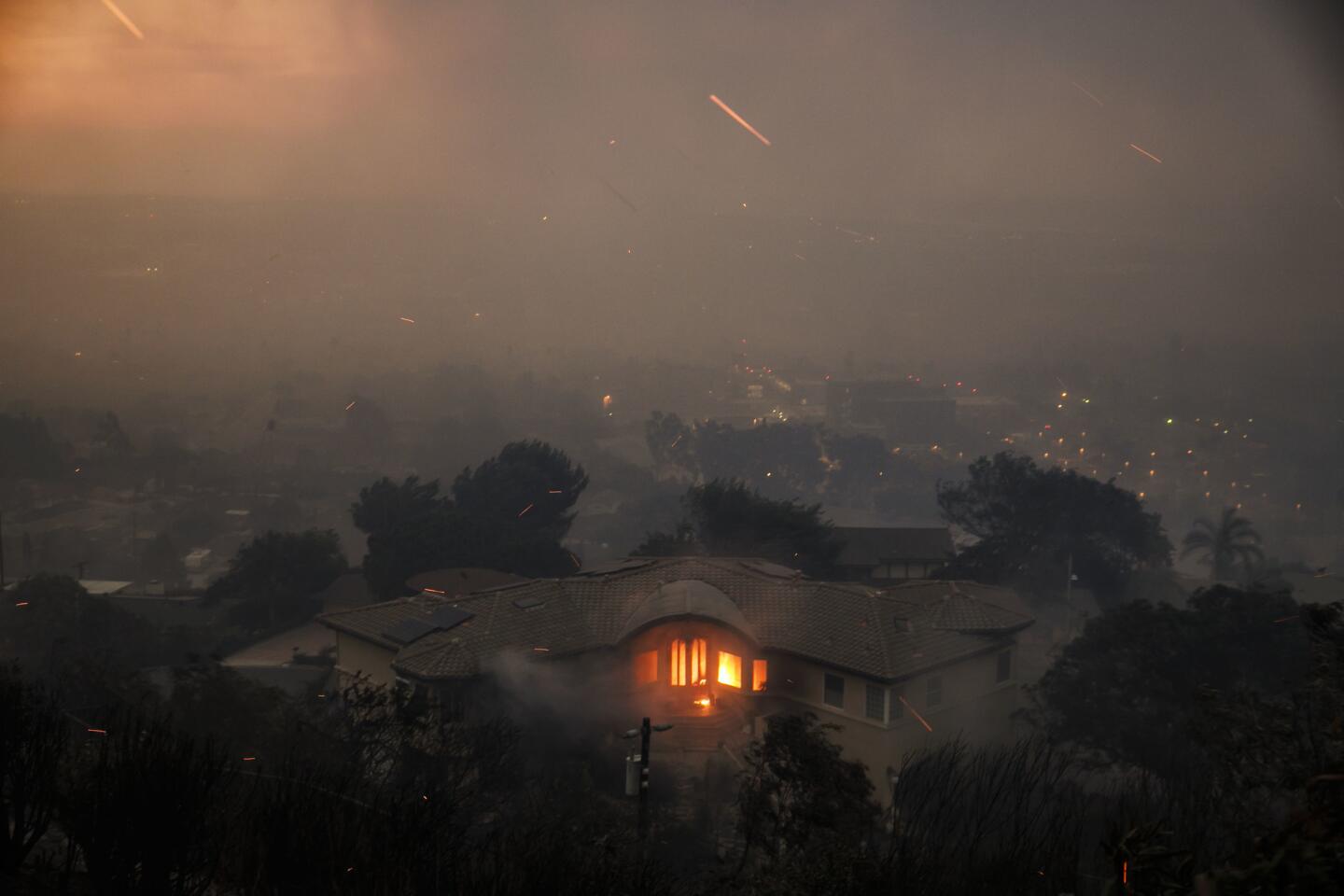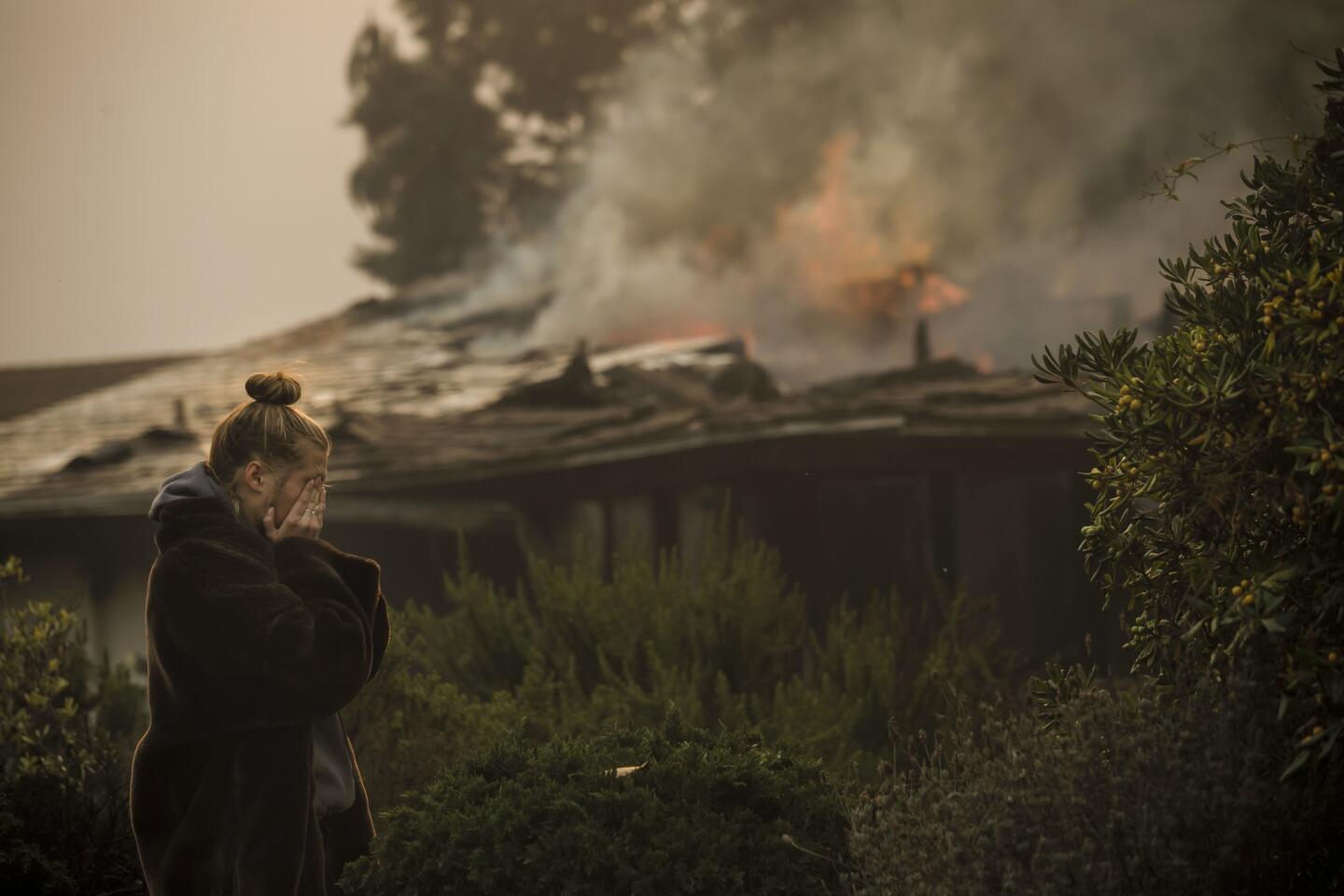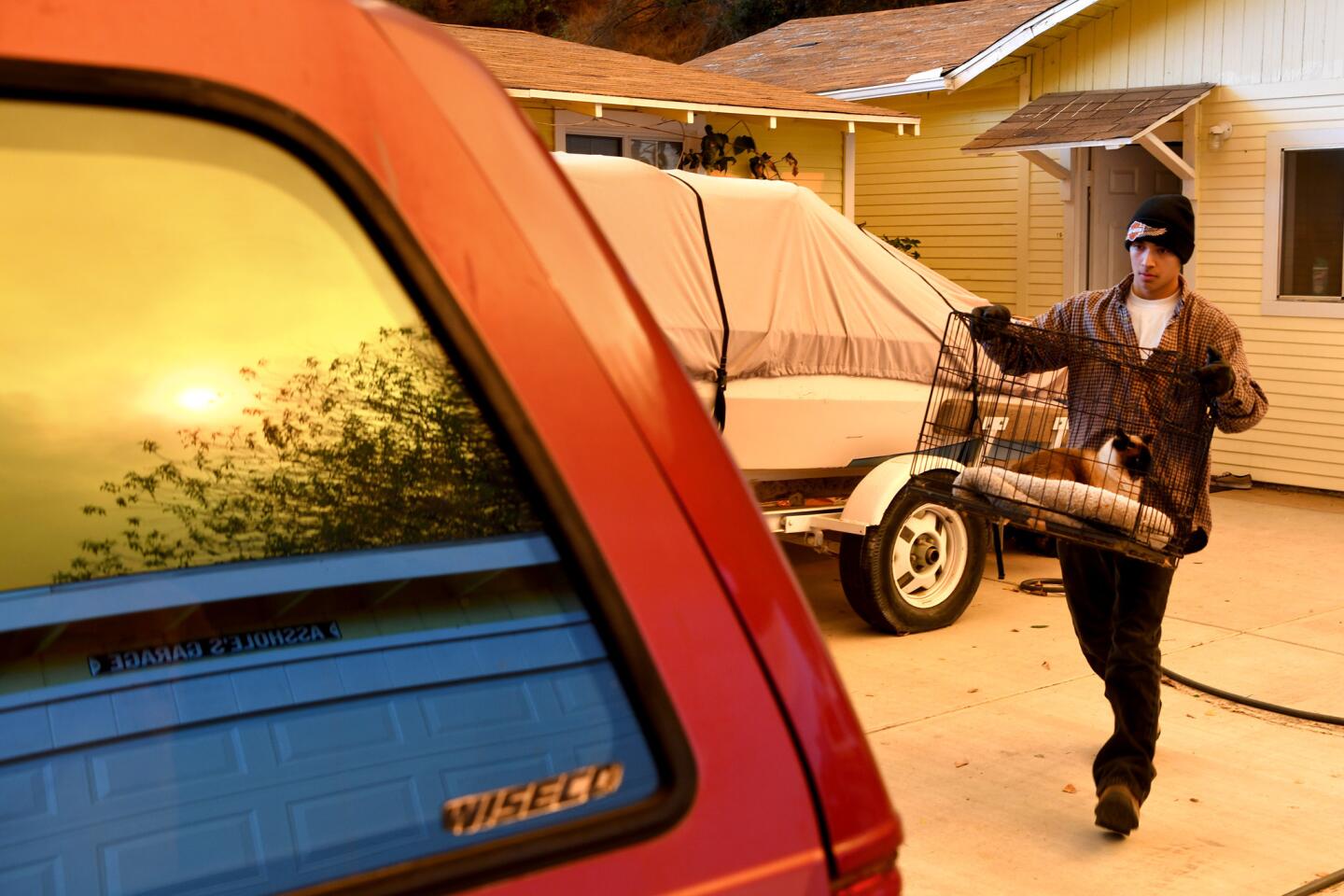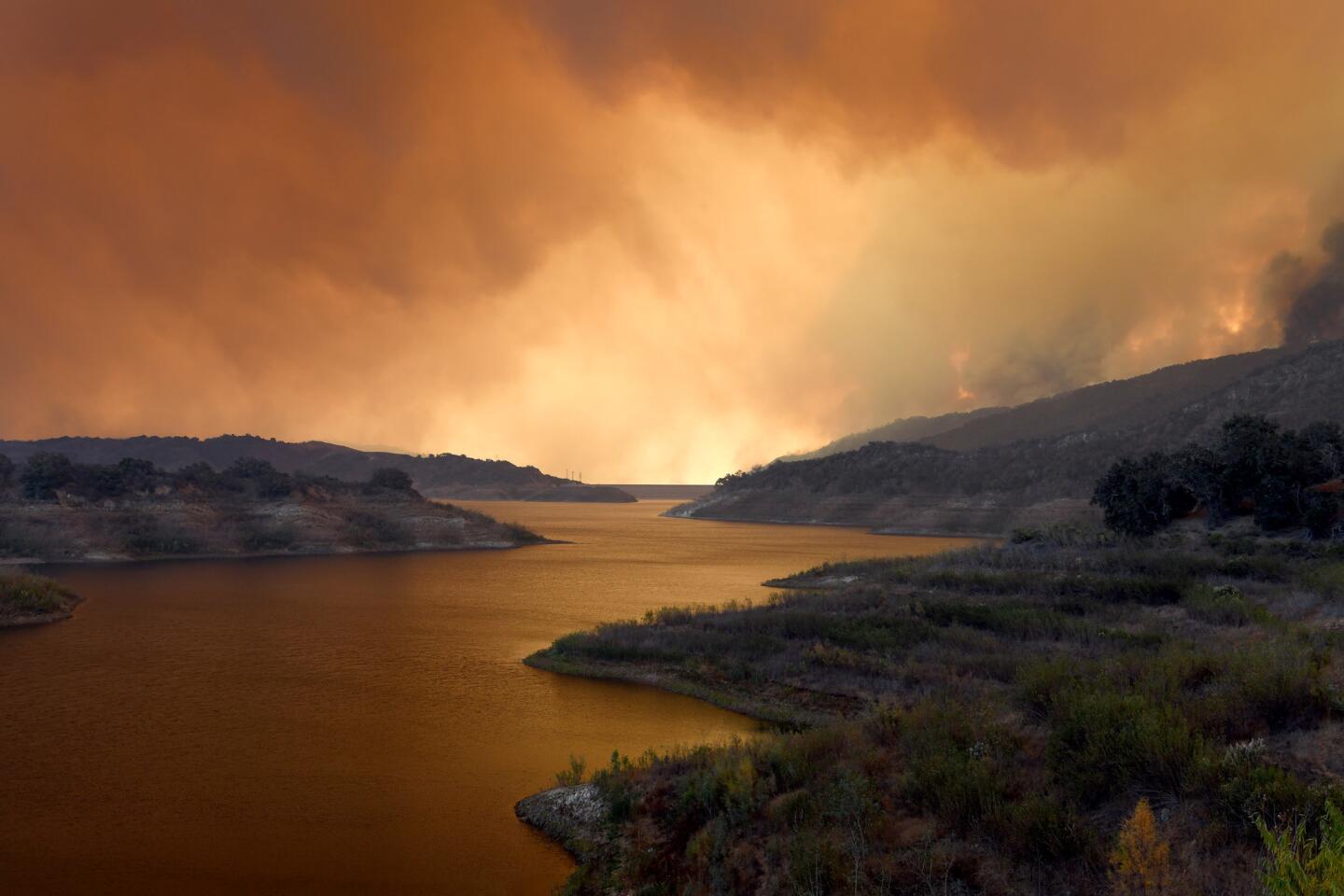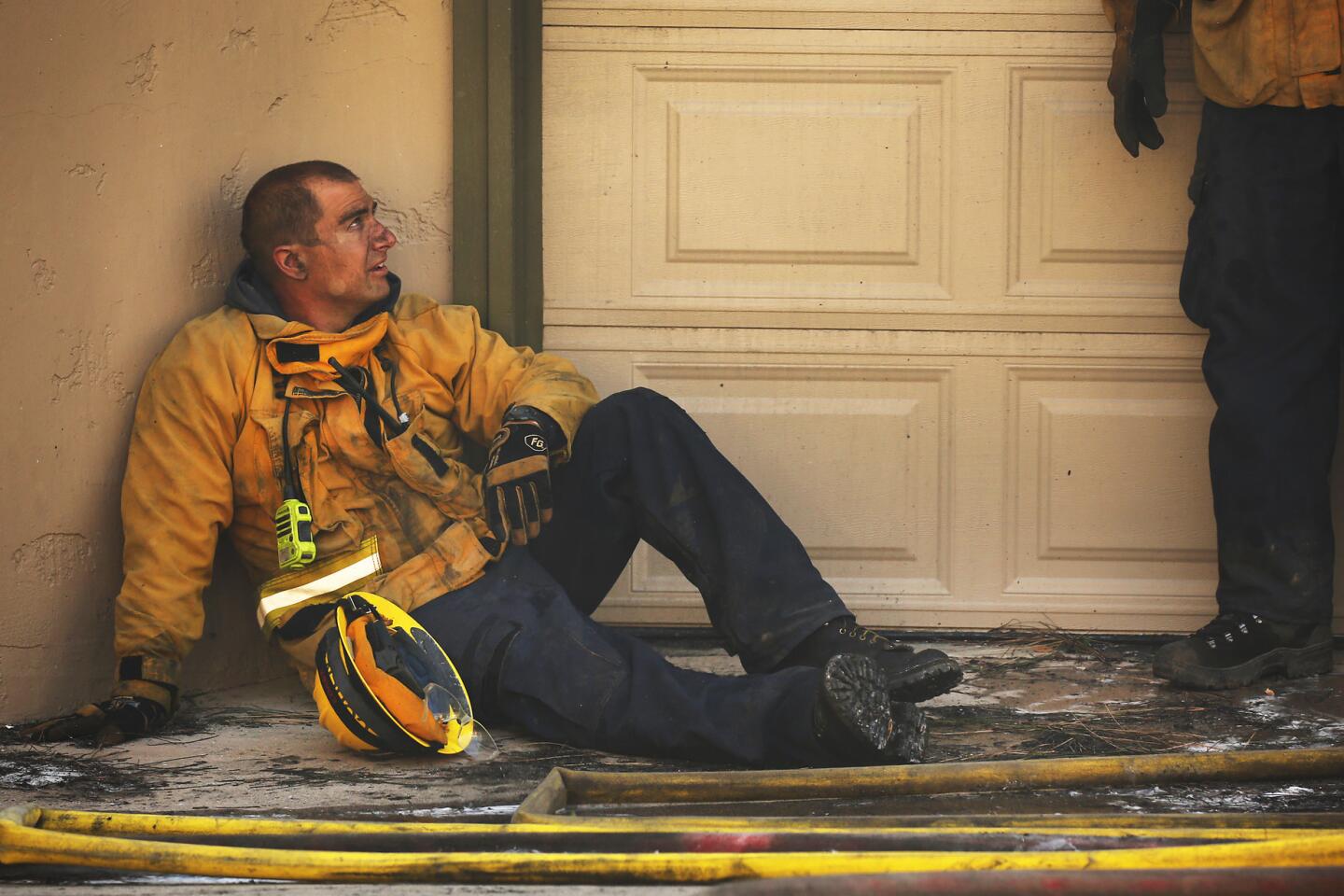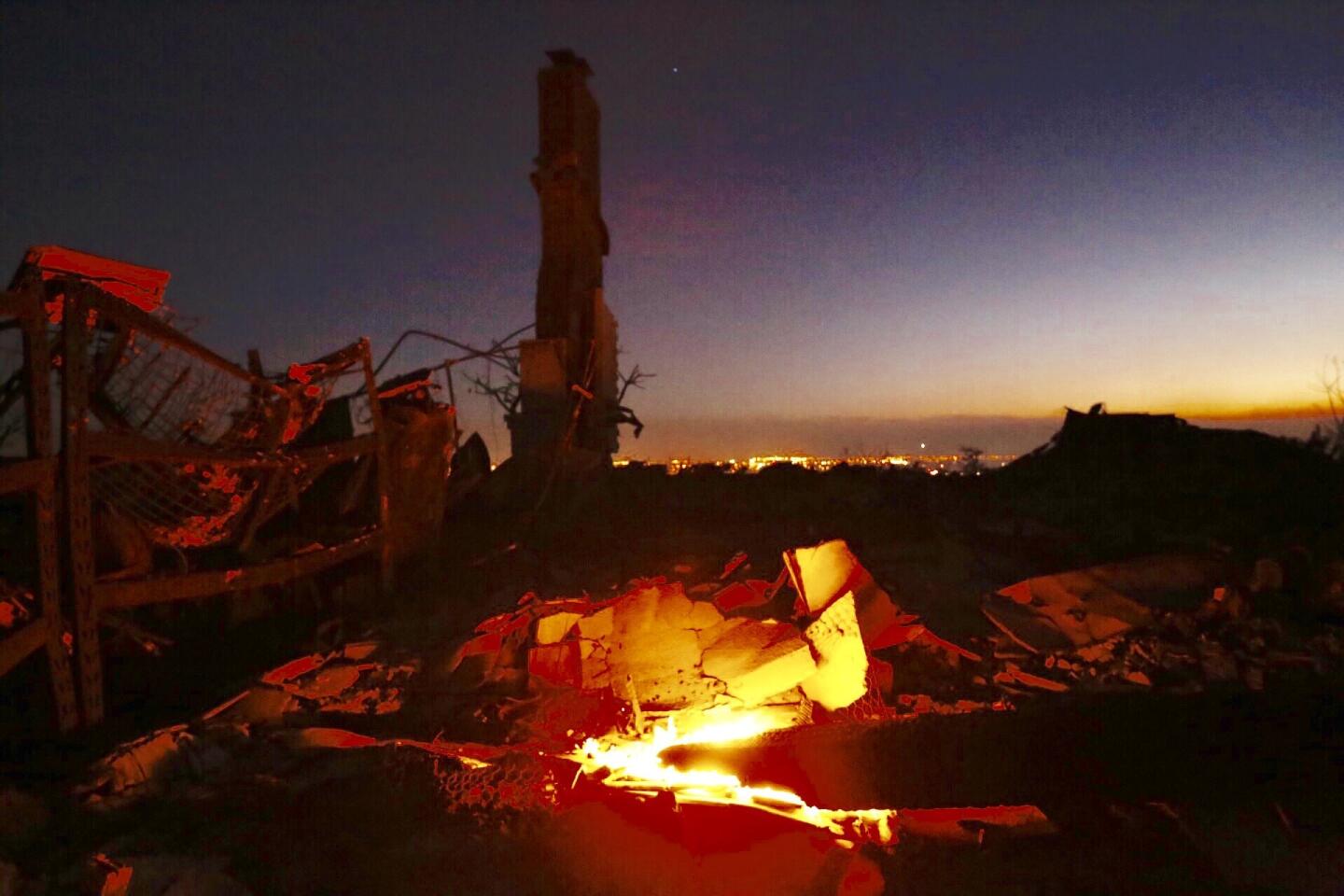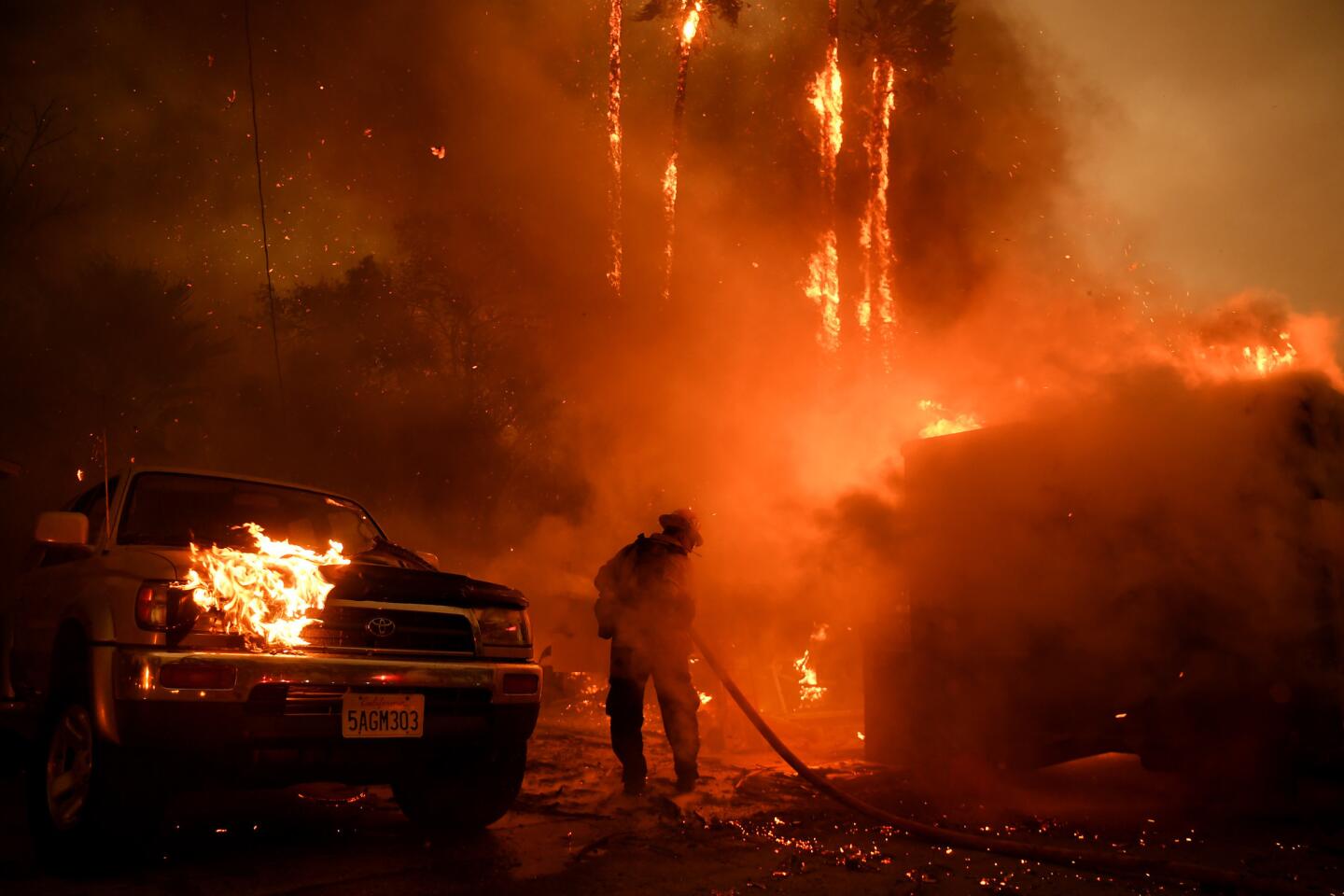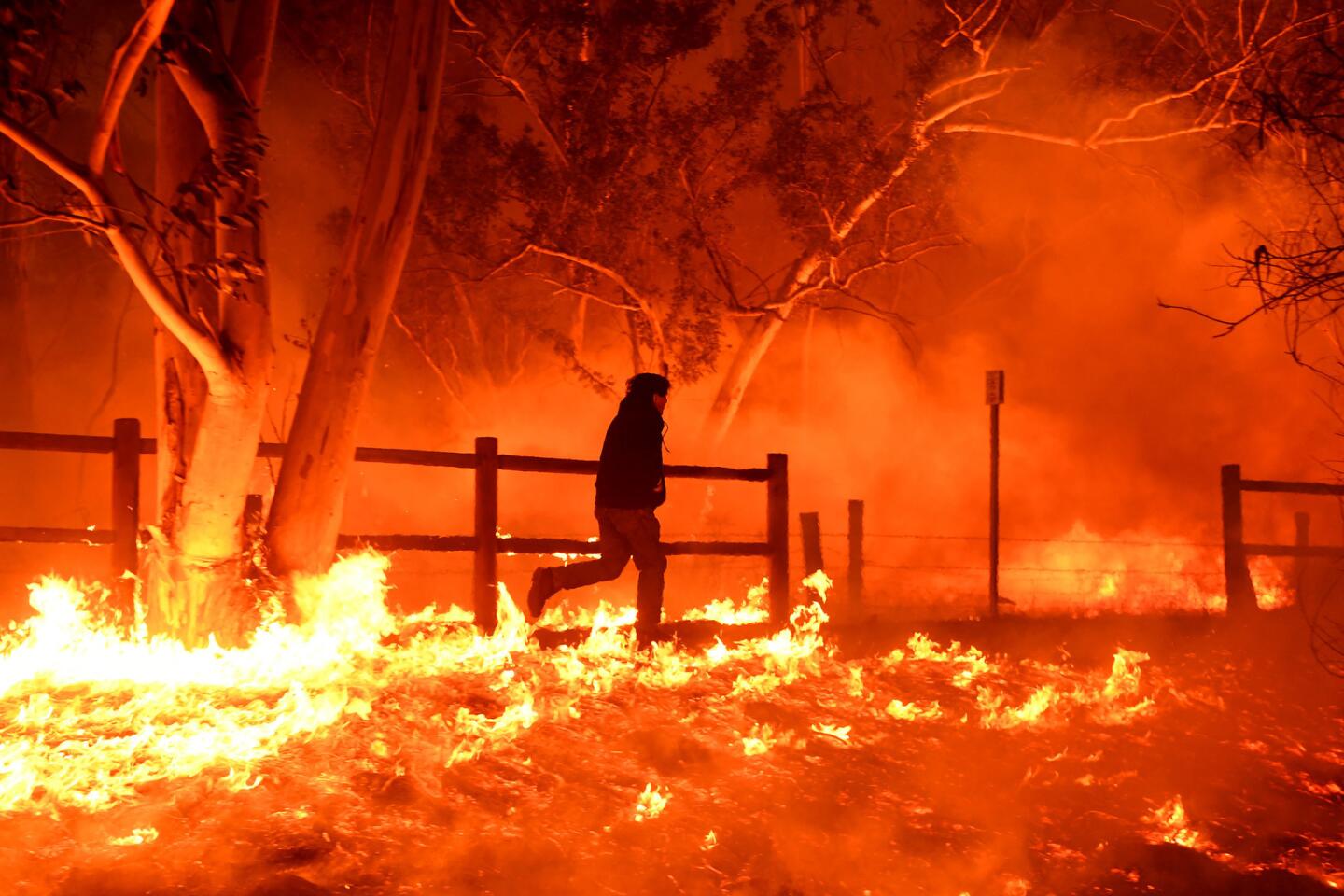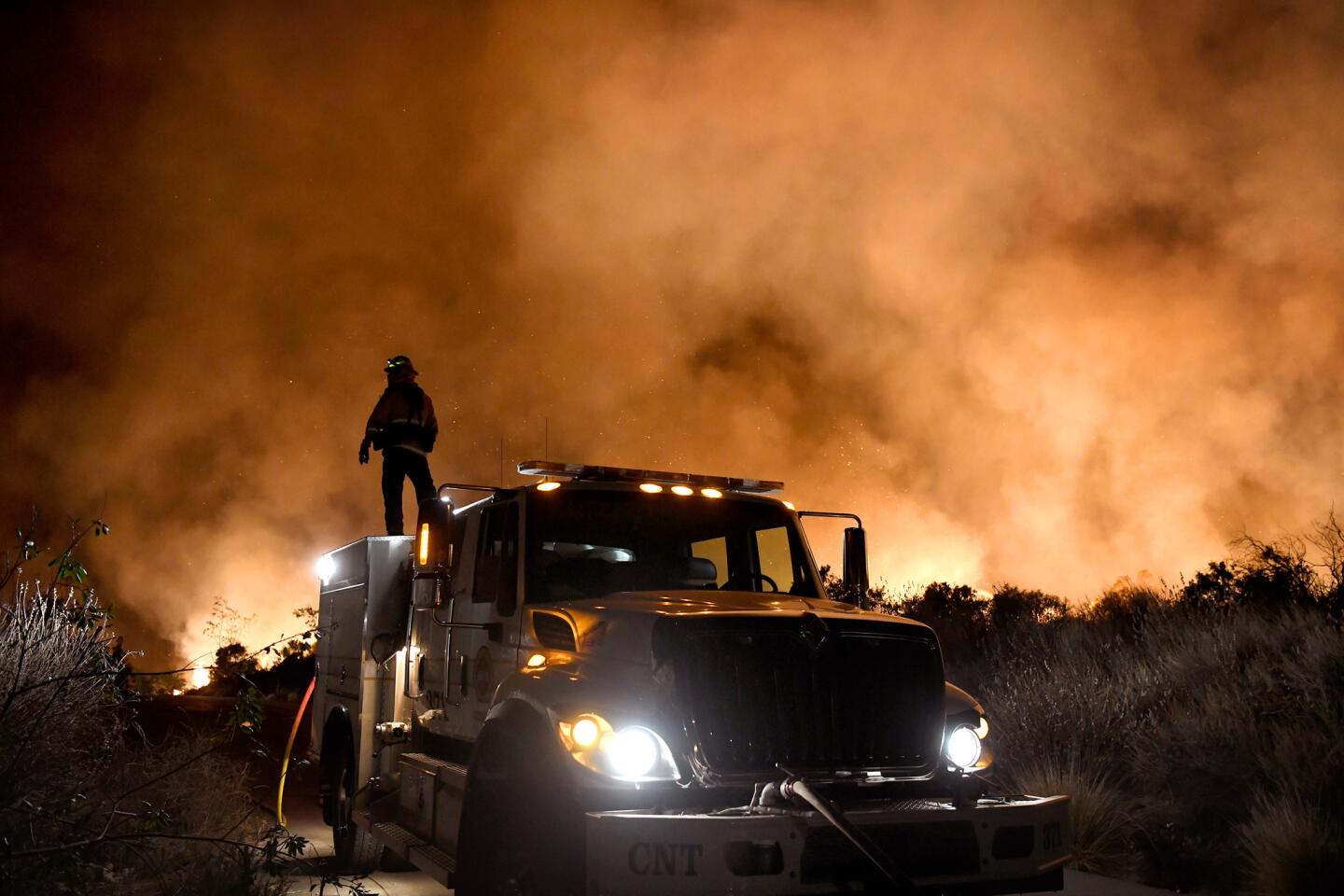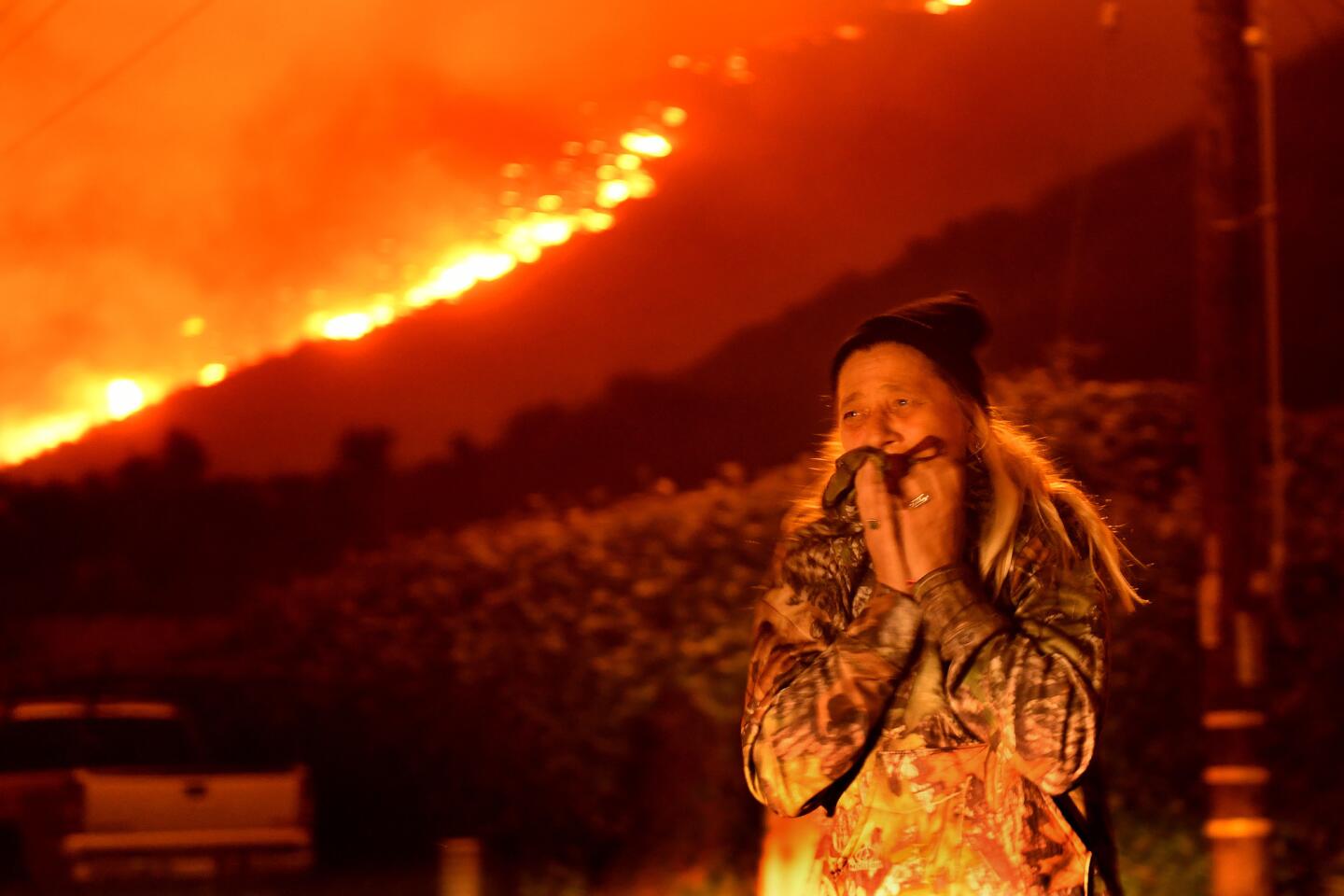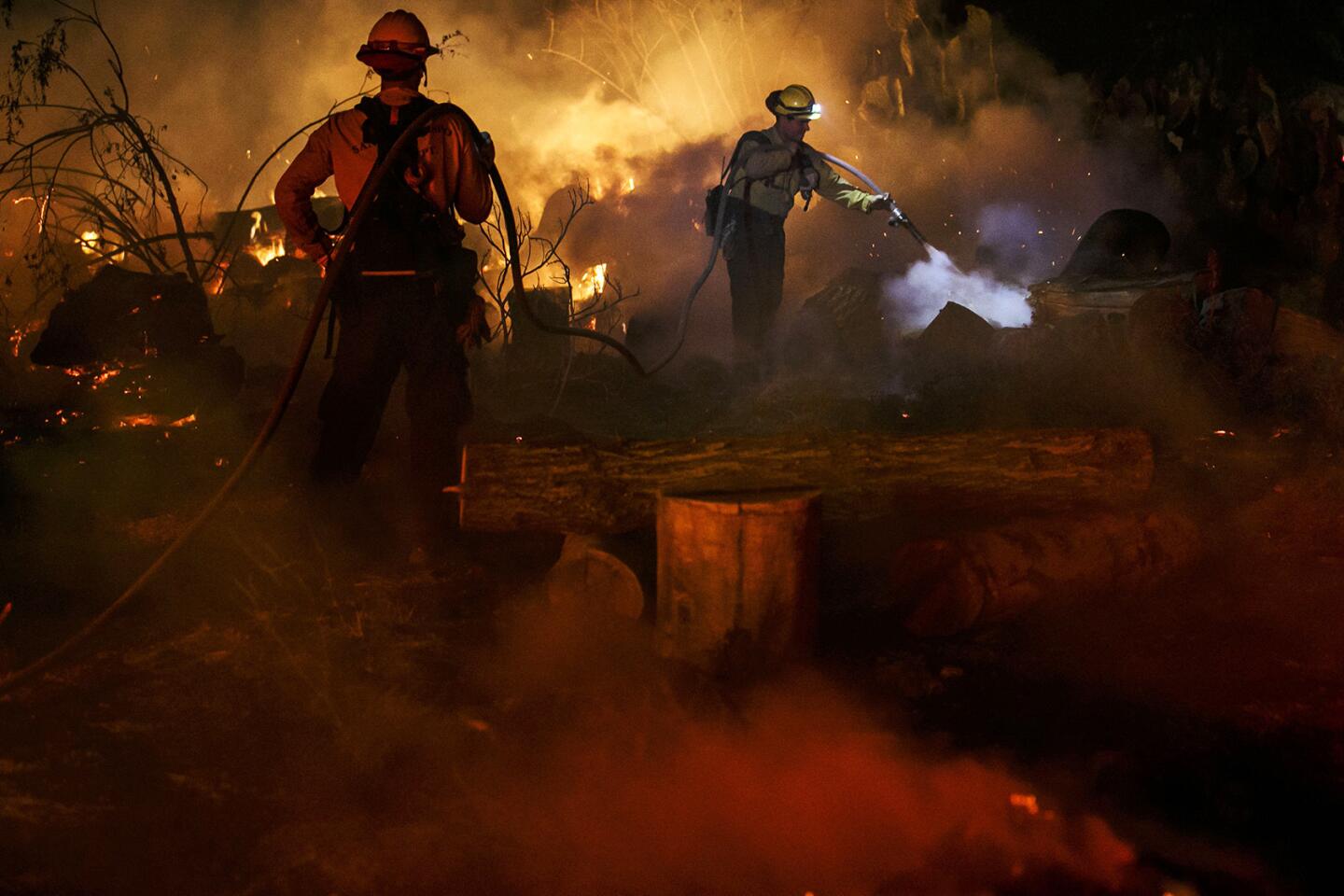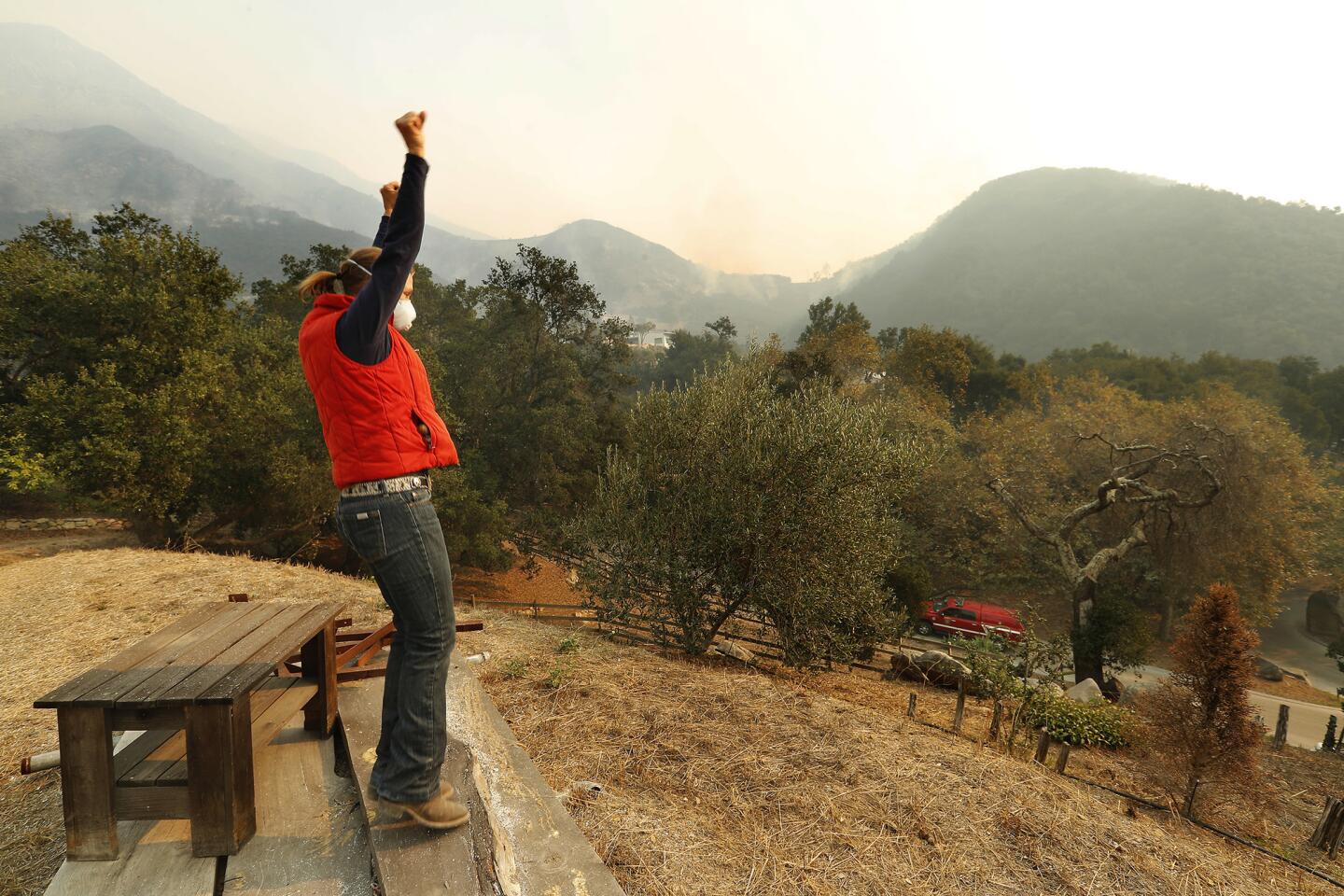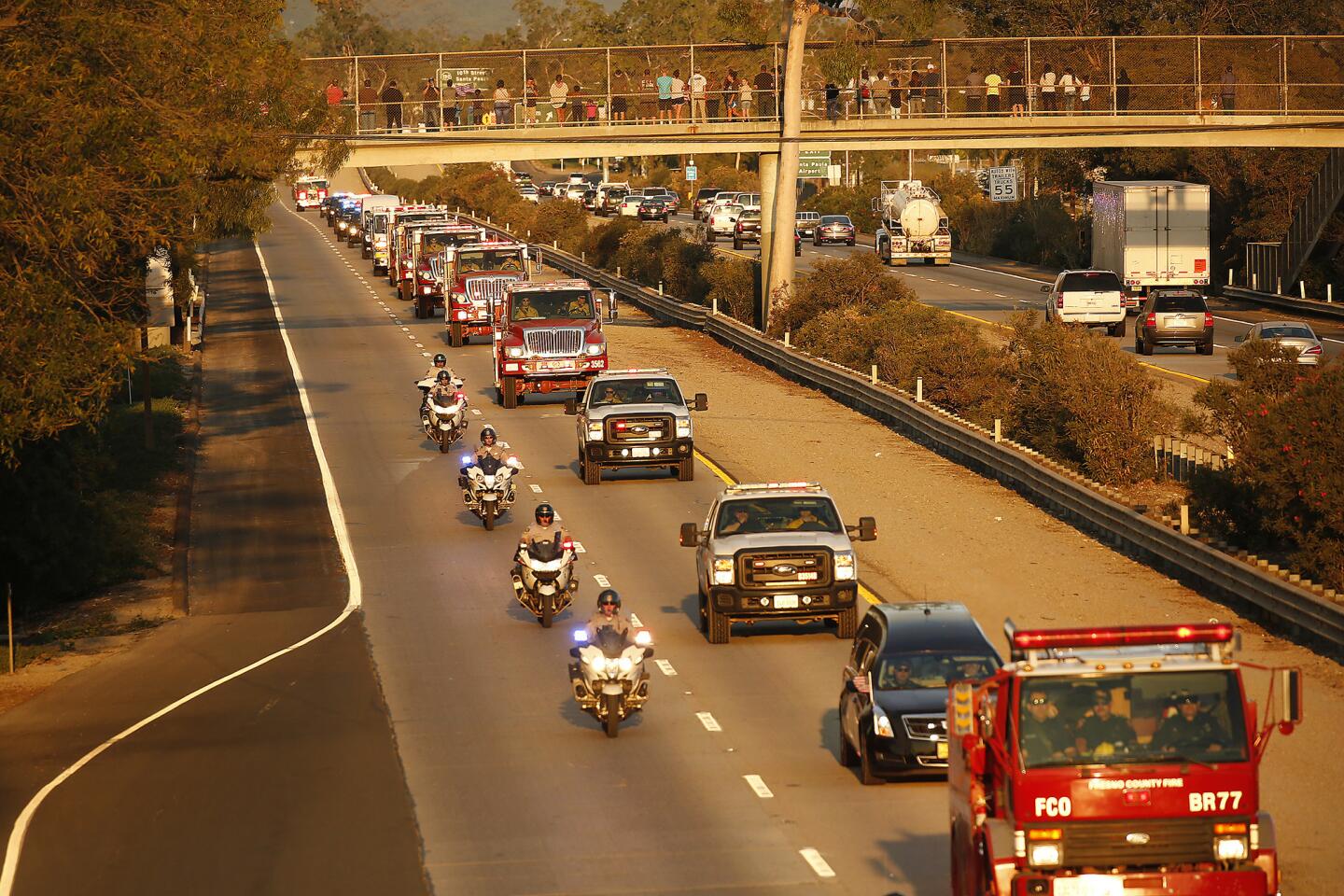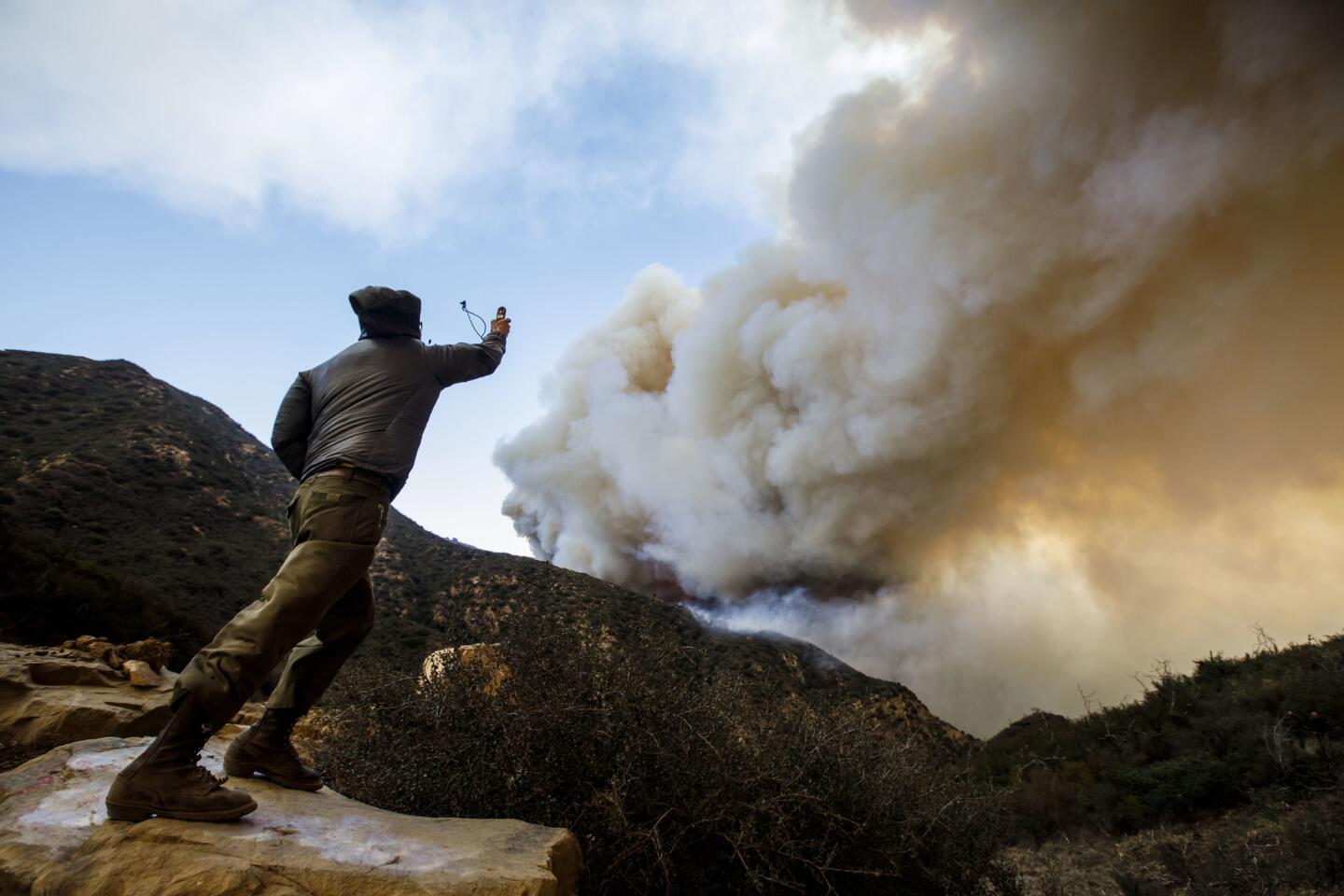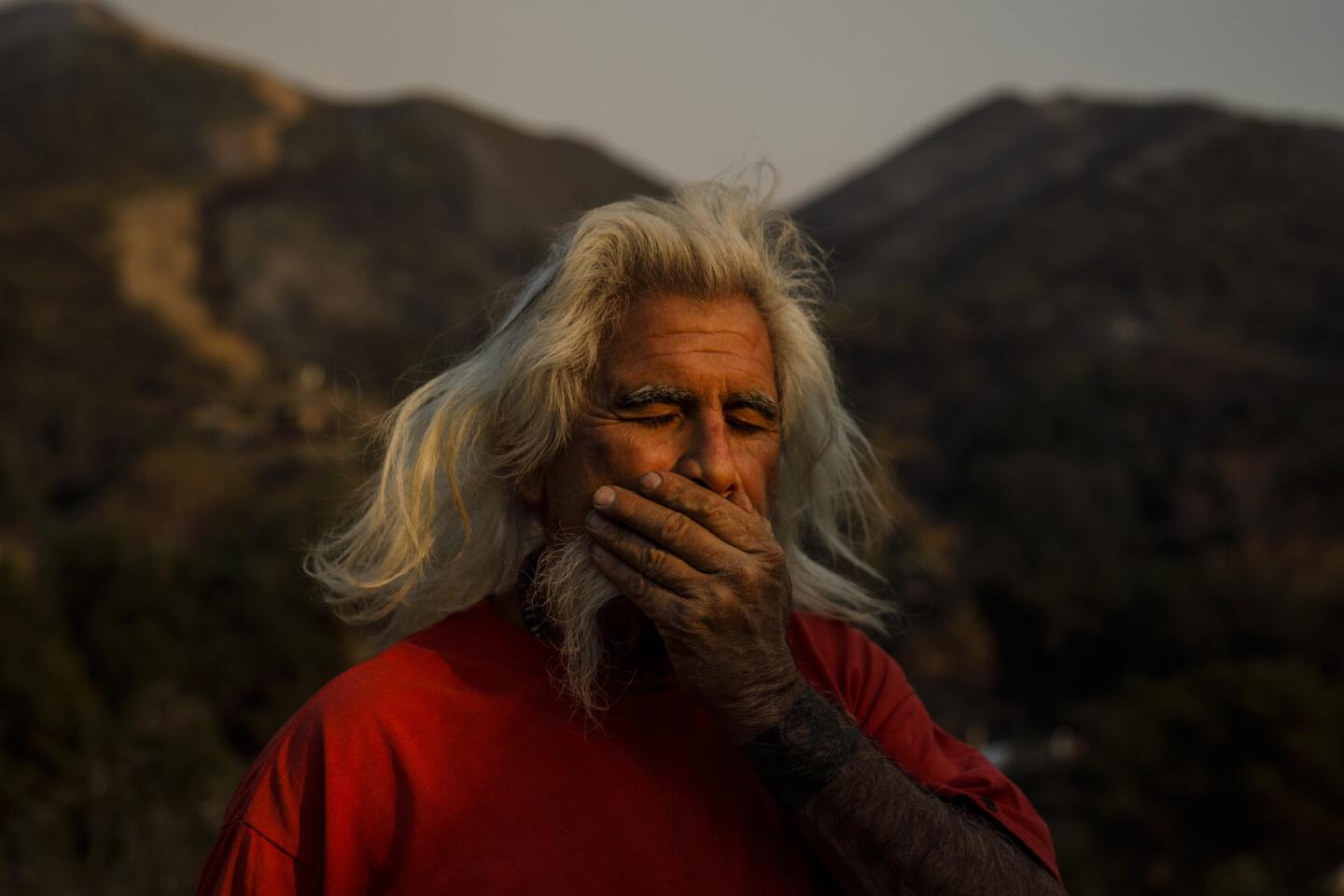Santa Ana winds roar through Southern California, whipping fires on destructive path
A series of Santa Ana wind-driven wildfires burned out of control in Southern California on Tuesday, destroying at least 180 structures, forcing thousands to flee and smothering the region with smoke in what officials predicted would be a pitched battle for days.
In Ventura, flames consumed dozens of stucco-and-tile homes along tidy streets and cul-de-sacs. Propane tanks exploded and fan palms became ragged torches lofting fiery debris hundreds of yards.
By morning, an estimated 150 structures were destroyed in scenes reminiscent of the deadly October firestorm that tore through Santa Rosa.
Late Tuesday, California Department of Forestry and Fire Protection officials said the number of homes burned in Ventura County could grow by hundreds.
As other fires erupted throughout the region, officials were quickly facing a triage situation.
The Creek fire broke out in the San Gabriel Mountain foothills before dawn and forced thousands to flee Sylmar and Lake View Terrace, burning 30 homes and quickly becoming one of the largest fires in modern Los Angeles history.
Authorities closed almost 20 miles of the 210 Freeway to allow additional firefighting crews to stream into the area, as thick smoke from 11,000 acres of charred chaparral billowed over the San Fernando Valley and prompted unhealthy air warnings as far away as Santa Monica and Malibu.
By 10 a.m., a third fire ignited, this time in the Santa Clarita Valley. It did not threaten homes but prompted the closure of Interstate 5. At 1 p.m. a fire in the San Bernardino foothills threatened the city’s Cal State campus and prompted the closure of the 215 Freeway. Smaller fires broke out in Riverside and Ontario.
Gov. Jerry Brown declared a state of emergency in Ventura County.
“This fire is very dangerous and spreading rapidly, but we’ll continue to attack it with all we’ve got,” Brown said. “It’s critical residents stay ready and evacuate immediately if told to do so.”
As of Tuesday evening, no fatalities had been reported. Two firefighters in the Sylmar area suffered injuries.
Officials said they had zero containment on the two most destructive fires, the Thomas and Creek. And the forecast was bleak, with seasonal dry winds, caused by high pressure over the Great Basin, not expected to relent until Thursday.
The National Weather Service called it “the strongest and longest duration Santa Ana wind event we have seen so far this season.”

Strong winds were pushing the blaze in a southwest direction toward the cities of Santa Paula and Ventura, leading to new evacuations of homes north of Foothill Road in Ventura and reports of power outages.
The last time powerful Santa Ana winds lasted three days, the agency said, was in 2007, when wildfires destroyed thousands of homes and killed 10 people as they swept down foothills from Santa Barbara to Baja California.
Although Southern California had a relatively quiet fire season until Monday, the state has suffered its deadliest year to date because of the fires in Northern California’s wine country in October that killed at least 44 people and burned down 10,000 structures.
That backdrop sharpened the anxiety of residents in evacuation zones Tuesday.
In upper Kagel Canyon, north of Lake View Terrace, Scott Wells woke up before dawn to the smell of smoke.
When he looked outside, brush was burning all around his house.
“It was pretty scary,” Wells said. The family had had close calls with fire before, but it was always coming from one side or another of their home. This time, he said, “it was all around us.”
In the mountains and foothills above Ventura, the Thomas fire had burned at least 55,000 acres by Tuesday evening, forcing 27,000 people to flee as it burned toward the heart of the historic coastal city. It jumped the 101 Freeway near Solimar Beach on its way to the Pacific Ocean.
In its path, staff at a canyon psychiatric hospital that specializes in treatment for post-traumatic stress disorder hastily had to evacuate patients in cars.
By Tuesday morning, at least two buildings of the campus lay in smoldering heaps of stucco and broken clay.
“I burst into tears,” said Sandy Case, 75, who lives next to Vista del Mar Hospital. “It broke my heart.”
“There’s a huge need for this facility,” said Roger Case, 76, who is on the hospital’s advisory board.
He said it serves about 80 patients at a time and employs about 230 people.
“There are all these people who are now unemployed,” Roger Case said.
The Case family’s home — a white colonial estate built in 1915 — was spared.
Such was the haphazard path of destruction so common in wind-driven fires.
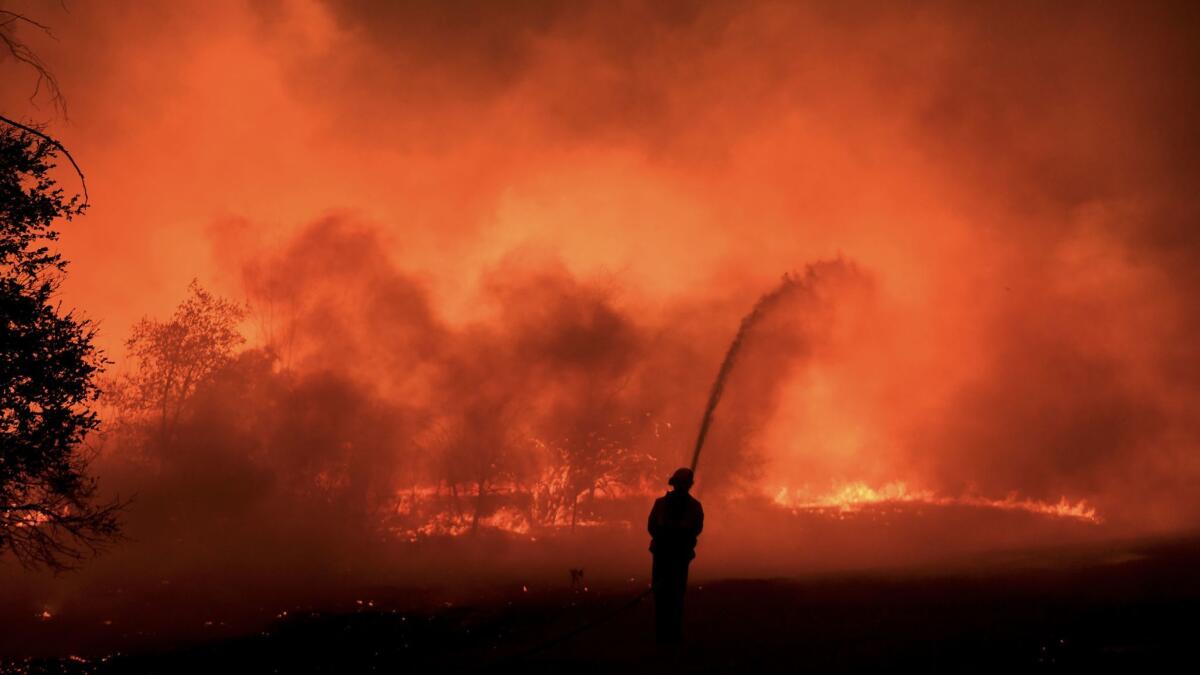
A fusillade of embers inevitably finds random openings in some homes — gaps under doors, poorly covered vents, open windows, flimsy doggy-doors — but not others. Once inside a house or garage, the embers can ignite all types of flammable material, from laundry to curtains to stacks of newspapers, quickly setting fire to walls and rafters. One burning house often sets off a chain reaction to neighboring homes, as the heat and flames shatter windows and catch eaves on fire.
Hundreds of firefighters worked through Monday night and Tuesday to prevent the fire from spreading as they were confronted by wind gusts of up to 60 mph.
The Hawaiian Village Apartments collapsed about 4 a.m.
Water gushed down North Laurel Street as firefighters worked to put out the flames in the complex and residents watched, holding cameras and cellphones. The sound of bursting propane tanks filled the air.
The Thomas fire started about 6:25 p.m. Monday in the foothills near Thomas Aquinas College in Santa Paula. It ballooned to more than 15 square miles in the hours that followed, roughly following Foothill Road to Ventura, churning through canyons with thick vegetation that hadn’t burned in decades, said Ventura County Fire Sgt. Eric Buschow.
Some residents hoped the worst might be over in the early hours of the morning when the wind died down. But it roared up again around daybreak, with 70-mph gusts in the mountains.
As the wind downed power lines and poles, more than 260,000 customers of Southern California Edison lost electricity.
Firefighters did not have a single flank of the fire contained, with 1,000 men and women fighting it and more on the way, said Ventura County Sheriff’s Department spokesman Tim Lochman. One helicopter was dropping water, and authorities were hoping winds would die down so they could deploy fixed-wing aircraft.
But firefighters found that some hydrants did not work because they required pumps that had lost power in the blackouts.

In Ojai, the entire water system went down — including hydrants and drinking water — when the pumping system itself was damaged by the fire.
Crews were working Tuesday to fix it.
In the canyons just outside Ojai, Marie McTavish and her family watched the flames crawl down Sulphur Mountain toward their ranch.
For more than 30 years, McTavish, 65, and her husband, Mike, 70, have owned a boarding stable for dozens of horses.
As the smoke blotted out the sun and the light turned an eerie magenta, the family knew the horses had to go.
They loaded more than 20 of them into trailers, headed to fairgrounds in Ventura and Santa Barbara. By the afternoon, three horses remained — the toughest and balkiest to get into trailers.
When the couple were ordered to evacuate around noon, they started to pack up their keepsakes, but looked at their barn — maroon, low-slung, half-century old, with a dozen horse stalls inside.
“Our barn is our lifeblood,” Marie McTavish said. “We have to fight, to save our barn.”
Her granddaughter Makayla Beverage, 13, grabbed a hose and soaked the barn and house, then filled up two trash cans on both roofs, hoping they might help firefighters if flames reached the structures.
“We could never rebuild it,” McTavish said. “I’m more worried about the barn than my house. It’s a landmark.”
Along Wheeler Canyon Road, a twisting mountain route north of downtown Santa Paula, Anita Ramirez stood in the driveway of a mobile home park.
The Santa Paula resident had agreed to go back and check on the home of a friend from church who had fled Monday night.
Ramirez peered beyond the yellow police tape blocking the property, put up by private security guards earlier in the day. Then she smiled.
“You’re so lucky,” Ramirez texted her friend. “It’s fine.”
She took a photo of the area, showing tidy rows of white, yellow and brown homes still standing on the left. On the right, wind and fire had left roofs caved in and walls crumpled. A blackened stove stood among the rubble in one home. Outside another, a child’s bike lay on its side in the street.
“Fate is funny,” Ramirez said. “If she had been on the other side of the street here, they might have lost everything.”
Times staff writers Joe Mozingo, Brittny Mejia, Cindy Carcamo, Louis Sahagun, Joseph Serna, Alejandra Reyes-Velarde, Melissa Etehad and Sonali Kohli contributed to this report.
Twitter: @laura_nelson
Twitter: @matthjourno
alene.tchekmedyian@latimes.com
Twitter: @alenetchek
More to Read
Sign up for Essential California
The most important California stories and recommendations in your inbox every morning.
You may occasionally receive promotional content from the Los Angeles Times.

